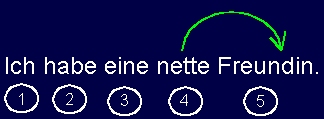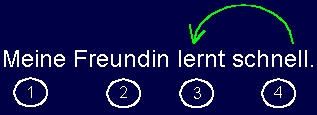

http://www.deutschseite.de
by ![]() Cathy & Tom
Cathy & Tom
last updated:
|
|
|
http://www.deutschseite.de |
|
| |||
I prepared this extra topic because I noticed that my gwapa has difficulties in the identification
of the single parts of a sentence. . However, this important so that you are able to handle the cases
and many other topics.
That's why we should speak talk about the components of a sentence:
example 1:
The woman kisses a man.

1: definite article
The definite article belongs to nouns and shows us in German which grammatical gender the noun has.
We use a definite article if we mean a certain noun (woman) and not any noun (woman).
2: subject
The woman is the acting person/thing in a sentence. The woman is doing something. She kisses.
3: verb
The verb is the action verb. It says what the subject does.
4: indefinite article
The indefinite article belongs to nouns and shows us in German which grammatical gender the noun has.
We use an indefinite article if we mean not a certain noun (man).
5: direct object
The direct object is the non-acting person/thing in a sentence. The man is kissed by the woman.
example 2:
The woman gives a book to the child.

1: definite article: see above (belongs to the subject)
2: subject: see above
3: verb: see above
4: definite article: see above (belongs to the indirect object)
5: indirect object
The indirect object is the beneficiary of the action in the sentence. Usually it's a person.
You can also say the indirect object is the receiver of the direct object
6: indefinite article: see above (belongs to the direct object)
7: direct object: see above
example 3:
I have a nice girlfriend.

1: subject: see above
2: verb: see above
3: indefinite article: see above (belongs to the direct object)
4: adjective
An adjective is a word which describes a noun.
How is my girlfriend? =>nice!
5: direct object: see above
example 4:
My girlfriend learns fast.

1: possessive pronoun
A possessive pronoun is a special pronoun which shows to whom or what the noun belongs.
Here the noun "Freundin" belongs to me.
2: subject: see above
3: verb: see above
4: adverb
An adverb is a word which describes a verb.
How does my girlfriend learn? => fast!
example 5:
I'll fly to Cagayan tomorrow.

1: subject: see above
2: verb: see above
3: time expression
As the name already describes the time expression says when something happens.
4: preposition
Prepositions are "relationship words".
They express time, location, causal ... relationships between people and things.
"Nach" is a typical "local preposition".
5: location
The name of the loacation is here "Cagayan".
example 6:
Cathy is a girl.

1: subject: see above
2: verb: see above
3: indefinite article: see above
4: predicate complement
The verb is a form of "be". The "ist" acts like an equal sign. You could say: Cathy = a girl.
That's why "Cathy" and "girl" are the subject and both are in the nominative case.
example 7:
Joy and Kristine go to the cinema.

1: subject: see above
2: conjunction: A conjunction connects two or more parts of a sentence.
Here "und" connects the both subjects.
3: subject: This sentence has 2 subjects. Both girl do something so they are both subjects.
4: verb: see above
5: preposition
"Ins" is a special preposition because actually it's a preposion and a definite article
"ins" is a short form of "in das".
6: location: see above
example 8:
Why do you learn German?

1: question word: question words ask for a reason, a time, a location, a person and so on.
2: verb: see above
3: subject: see above
4: direct object: see above
example 9:
When do you go?

1: question word: see above
2: verb: see above
3: subject: see above
example 10:
Give me a kiss!

1: verb: see above
2: indirect object: see above
3: indefinite article: see above
4: direct object: see above
example 11:
Ich vermisse Cathy und ihre Freunde.

1: subject: see above
2: verb: see above
3: direct object: see above
4: conjunction: see above
5: possessive pronoun: see above
6: direct object: see above
example 12:
Germany has 16 "Bundesländer".

1: subject: see above
2: verb: see above
3: number: how many of something
4: direct object: see above
summary
1.) Every sentence contains a subject (statements and questions). |
2.) It might be that one sentence has 2 or more subjects (see example 7). |
3.) Not every sentence contains an object. Many sentences don't have any object (see examples 4, 5, 6, 7, 9). |
4.) Some sentences contain even more than one object (see example 11). |
5.) The components of a sentence we learnt so far are:
|
exercises |
| |||||
summary - documents for your folder |
Satzbestandteile erkennen (theory, 5 pages) |
| ||